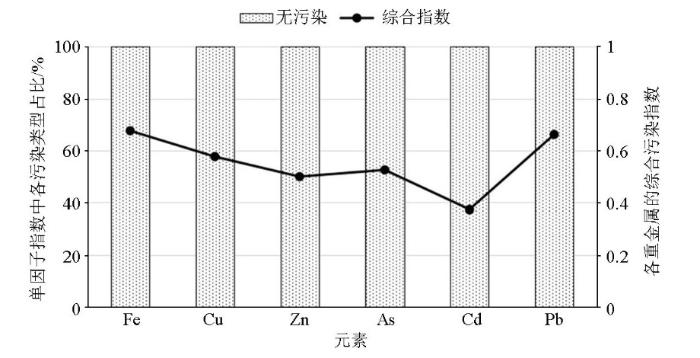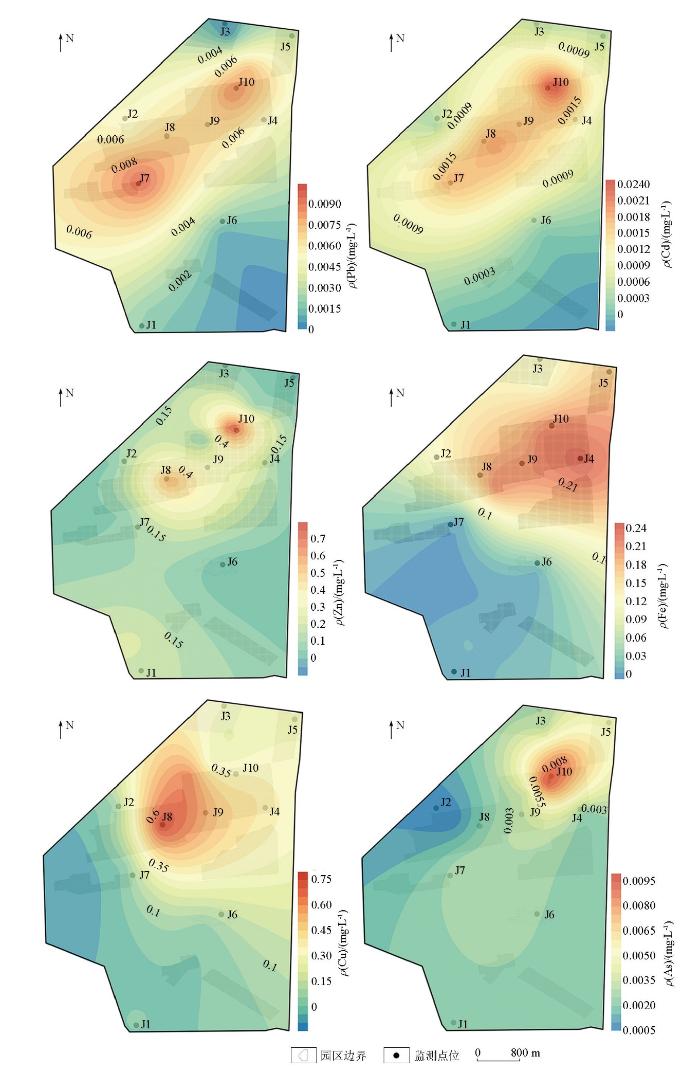0 引言
化工园区是化工产业发展的重要载体,是现代化工业产业发展的未来空间。化工原料、产品的性质决定了化工园区具有潜在的危险性。2021年12月《地下水管理条例》颁布实施,标志着地下水迈入依法严管的新阶段。目前国内外学者如Pokkate等[13]、倪彬等[14]、Chotpantarat等[15]、Rattan等[16]和Zhang等[17]针对农业灌溉区或饮用水源地下水中重金属污染开展了较多的研究,基本认为成人的健康风险值要高于儿童,饮用途径的健康风险要高于其他途径等,但关于典型化工园区地下水重金属污染特征及其环境风险的研究报道较少。本次以山东省地质勘查基金项目为依托,选取某典型化工园区内6种重金属元素(Fe、Cu、Zn、As、Cd、Pb),采用内梅罗综合污染指数法对研究区地下水水质污染现状进行评价[18],根据现场调查结合重金属空间分布特征识别地下水重金属污染来源,最后利用USEPA健康风险评价模型对评价区儿童、成人开展健康风险评价,可为相关管理部门对地下水资源保护、改良以及提升周边居民幸福生活指数提供科学依据。
1 材料与方法
1.1 研究区概况
研究区位于鲁西北某县,属于暖温带半湿润大陆性季风气候,四季分明,平均年降水量527.1 mm,境内春季多西南风,冬季多东北、西北风。研究区位于黄河下游冲积平原,地势平缓,地形呈自西南向东北倾斜,海拔9~11 m,依据平原地貌的形态、成因类型等特征,区内微地貌属于浅平洼地。研究区属于华北地台的中、新生代断陷盆地,中生代以来,沉积了巨厚的新生界地层,以第四系和新近系为主。研究区属于鲁西北平原松散岩类水文地质区,地下水类型为松散岩类孔隙地下水,主要化学类型为重碳酸盐型,含水层岩性以粉细砂及粉土为主,含水层厚度0.8~2.0 m,在水平方向上含水层多呈舌状和透镜体状分布,在垂直方向上含水层与相对隔水层交错分布,富水性及径流条件较差。区域水文地质详见图1。
图1
1.2 样品采集与分析
研究区目前建设面积12 km2,以化工新材料、专用精细化学品及石化深加工为主要生产产业,通过企业产品、原辅材料、生产工艺及“三废”排放,识别化工园区特征污染物主要为铅、镉、铬、砷、镍等重金属以及苯系物、石油类化合物等。园区周边基本为农田、村庄,无工矿企业分布。点位布设依据《化工园区地下水环境状况调查评估技术方案》[19],在化工园区的上游、垂直于地下水流向方向两侧、下游以及内部主要敏感点附近共布设监测井10口,其中新建井5口,井深8.8~10.0 m,口径160 mm,管壁结构为PVC材质;借用园区、企业自行监测井5口,井深9.0~11.0 m,口径110mm,管壁结构为PVC材质。点位分布见图2。
图2
图2
研究区平面布置及采样点位分布
Fig.2
Layout plan of the study area and distribution of sampling sites
2021年9月,在丰水期期间采集地下水样品10件,现场使用HX-W便携式水质多参数检测仪检测并记录样品pH、温度、浊度、电导率、溶解氧等水质基本参数,用0.45 μm的微孔滤膜对样品处理后装于500 mL棕色玻璃瓶中,加入3 mL 65%的硝酸,调节pH至2以下,置于4 ℃的保温箱冷藏保存。样品分析测试工作由山东省地矿局中心实验室完成,测试方法依据《环境监测分析方法标准制定技术导则》(HJ 168—2020)[20],其中Cu、Zn、As、Cd、Pb运用电感耦合等离子体质谱仪(ICP-MS,Perkin Elmer,USA)分析测定,Fe运用电感耦合等离子体发射光谱仪(ICP-OES,Perkin Elmer,USA)分析测定。测试过程中采取空白实验、精密度控制、准确度控制等多种方式进行质量控制。根据质量控制报告可知,空白样品分析测试结果均低于各元素分析方法检出限,精密度控制合格率96.3%~100%,加标回收率范围在70%~130%,样品测定结果均在误差允许范围内。
1.3 研究方法
1.3.1 描述性和多元统计
实验数据处理及相关参数统计采用SPSS19.0(IBM Inc.,Armonk,NY,USA)和Origin2021b(Origin Lab Corporation.,Northampton,MA,USA),图件制作采用ArcGIS 10.2(Esri,Redlands,CA,USA)进行空间插值,图形处理采用CorelDrawX8(Corel,Ottawa,Canada)[21]。
1.3.2 水质污染现状评价
表1 参数取值含义
Table 1
| 参数定义范围 | 含义 | |
|---|---|---|
| Pi≤1.0 | P综≤0.7 | 无污染 |
| 1.0<Pi≤2.0 | 0.7<P综≤1.0 | 轻微污染 |
| 2.0<Pi≤3.0 | 1.0<P综≤2.0 | 轻度污染 |
| 3.0<Pi≤5.0 | 2.0<P综≤3.0 | 中度污染 |
| Pi>5.0 | P综>3.0 | 重度污染 |
1.3.3 健康风险评价
健康风险评价是以地下水质量标准和风险评价的健康基准值为基础,通过把地下水污染和人体健康相联系,定量描述污染物对人体健康的危害概率,是非常有效的评价方法[26-27]。目前,美国国家环保署(USEPA)推荐的人体健康风险评估模型可运用于各种环境介质、多种污染物健康风险评价[28]。因此,本次研究采用USEPA水环境健康风险评价模型,对化工园区附近居民人体健康进行风险评价。地下水暴露途径主要为饮用和皮肤接触两种[29],暴露概念模型见图3,评价内容主要分为暴露剂量计算和健康风险表征两部分。考虑到国外的模型与我国实际情况会有所不同,因此通过查阅相关资料对暴露参数进行了一定的修改,以便得到的结果能更好地反映研究区的真实情况[30]。
图3
图3
研究区污染物风险暴露概念模型
Fig.3
Conceptual model of pollutant risk exposure in the study area
1)暴露剂量计算
暴露剂量分为非致癌性物质的暴露量和致癌性物质的暴露量,致癌性物质暴露剂量用终生日均暴露剂量(LADD)表示,非致癌性物质的暴露剂量用日均暴露剂量(ADD)表示。其表达式如下[31]:
式中:LADDder和ADDder分别表示皮肤暴露途径下的致癌和非致癌性污染的日均暴露剂量,mg/(kg·d);LADDoral和ADDoral分别表示饮用途径下的致癌和非致癌性污染的日均暴露剂量,mg/(kg·d)。式中各参数取值见表2。
表2 健康风险评价暴露参数值
Table 2
| 参数符号及单位 | 参数含义 | 成人参考值 | 儿童参考值 | 参数来源 |
|---|---|---|---|---|
| C/(mg·L-1) | 污染物浓度 | Ci | Ci | 本次研究 |
| ED/a | 持续暴露时间 | 30 | 9 | [32-3] |
| ET/(d·a-1) | 暴露时间 | 360 | 360 | [32-3] |
| EF/(d·a-1) | 暴露频率 | 350 | 350 | [32-3] |
| SA/cm2 | 接触的皮肤表面积 | 16000 | 9300 | [32-3] |
| PC/(cm·h-1) | 皮肤渗透系数 | 0.0001(Fe)、0.0006(Cu)、0.0006(Zn)、 0.0018(As)、0.001(Cd)、0.000004(Pb) | [34] | |
| CF/(L·cm-1) | 体积转换因子 | 0.001 | 0.001 | [34] |
| IR/(L·d-1) | 每日平均饮用量 | 1.70 | 1.14 | [32-3] |
| BW/kg | 平均体重 | 57.00 | 23.80 | [32-3] |
| AT/d | 平均暴露时间 | 25500 | 25500 | [32-3] |
2)健康风险表征
将化学物质按照其毒理学性质分为非致癌性物质(Fe、Zn、Cu和Pb)和致癌性物质(As、Cd)两类,健康风险评价模型表达式如下[31]:
表3 致癌强度系数(q)和日均参考剂量(RfD)
Table 3
2 结果与讨论
2.1 重金属描述性统计分析
研究区6种重金属浓度调查结果见表4,可以看出,重金属的浓度差异性较大,Fe、Cu、Zn、As、Cd和Pb的平均值分别为0.133、0.277、0.196、0.003 8、0.001和0.005 4 mg/L,均高于山东省浅层地下水背景值[37]。除Fe和Pb外,其余重金属偏度均大于0,属于正偏斜。变异系数是反映各监测点地下水中重金属空间分布离散程度,变异系数越大,离散程度越大:小于20%属于低变异度;20%~50%属于中等变异度;50%~100%属于高变异度[38]。研究区所有监测点的变异系数均大于50%,其中Zn的变异系数最大,为130.1%。所有重金属均为高度变异,离散程度较大,说明重金属受研究区工业生产活动影响较明显,不同重金属之间的污染途径及污染物来源可能不同。
表4 地下水重金属浓度分析统计
Table 4
| 元素 | 最小值 /(mg·L-1) | 最大值 /(mg·L-1) | 平均值 /(mg·L-1) | 背景值 /(mg·L-1) | 标准差 /(mg·L-1) | 变异系 数/% | 偏度 | 峰度 | 超标率 /% | 国家Ⅲ类 标准 |
|---|---|---|---|---|---|---|---|---|---|---|
| Fe | 0.003 | 0.294 | 0.133 | 0.049 | 0.107 | 70.9 | -0.499 | -1.362 | 0.00 | 0.3 |
| Cu | 0.005 | 0.756 | 0.277 | 0.003 | 0.268 | 96.8 | 0.639 | -0.702 | 0.00 | 1.00 |
| Zn | 0.003 | 0.762 | 0.196 | 0.019 | 0.255 | 130.1 | 1.74 | 1.946 | 0.00 | 1.00 |
| As | 0.0005 | 0.0094 | 0.0038 | 0.00057 | 0.0028 | 73.7 | 1.36 | 0.961 | 0.00 | 0.01 |
| Cd | 0.00005 | 0.00245 | 0.0010 | 0.00004 | 0.00082 | 82.0 | 0.409 | -1.105 | 0.00 | 0.005 |
| Pb | 0.0005 | 0.0098 | 0.0054 | 0.0009 | 0.0033 | 61.1 | -0.399 | -1.275 | 0.00 | 0.01 |
2.2 污染评价及空间分布特征
采用修正的内梅罗污染指数法对研究区地下水重金属污染状况进行评价(图4),计算其单因子污染指数和综合污染指数,其中J1位于园区上游,可作为对照点。由单因子污染指数评价数据可知,评价区地下水中Fe、Pb、Cu、As、Zn、Cd重金属元素均为无污染。Fe、Pb、Cu、As、Zn和Cd单因子污染指数范围分别为0.36~0.76、0.26~0.78、0.01~0.76、0.01~0.70、0.35~0.55和0.01~0.48;综合污染指数分别为0.68、0.66、0.58、0.53、0.50和0.37。
图4
图4
单因子污染指数与综合污染指数评价地下水重金属
Fig.4
Evaluation of heavy metals in groundwater by single factor pollution index and comprehensive pollution index
图5
图5
研究区地下水重金属浓度空间分布特征
Fig.5
Spatial distribution characteristics of groundwater heavy metal concentration in the study area
采用ArcGIS 10.2反距离权重插值法对研究区10个采样点的重金属进行插值,来分析地下水重金属含量空间分布特征(图5)。由图5可以看出:①Zn、Cd和As空间分布具有一定的相似性,高值区采样点主要位于J10,扩散趋势从西南向东北逐渐加重。根据现场调查可知,J10位于企业(行业类型为染料制造)试验装置区北,地下水流向下游,该功能区主要对研制的颜料进行试生产,该区域包含了厂区全部原材料和生产工艺,生产工艺及原辅材料较复杂,生产装置有腐蚀痕迹,地面颜色异常,且地面存在破损,推测企业生产活动在一定程度上增大了该区域重金属浓度;②Pb高值区采样点主要位于J7,扩散趋势沿西南向递减。该企业行业类型为其他电池制造,主要生产铅酸蓄电池,原辅材料使用大量的铅粉,判断Pb主要受该企业生产活动影响;③Fe高值区采样点主要位于J4、J10,面积较广,扩散趋势沿东北方向递增。J4位于企业(行业类型为炼铁)烧结车间东,该功能区用矿粉、生石灰、菱镁粉、焦粉等烧结生产成品烧结矿,产生的废气主要为颗粒物、铁粉、铅尘等,废水主要为含氧化铁皮和少量油,部分设备存在“跑、冒、滴、漏”现象,可能是引起地下水Fe富集的主要原因。④Cu高值区采样点主要位于J8,扩散趋势沿东北向递减。J8位于企业(行业类型为基础化学原料制造)污水处理东,污水处理站对全厂生产的污水进行处理,为全厂污染风险最大的地方,且污水处理站周边存在砖铺地面,气味异常,周边硬化有破损迹象,推测企业生产活动是引起地下水Cu富集的主要原因。
2.3 人体健康风险评价
根据美国国家环保署推荐的健康风险评价模型,计算出该典型化工园区地下水中Fe、Cu、Zn、As、Cd和Pb等重金属元素通过饮用和皮肤接触途径下的健康风险。由图6a、b可知,在皮肤接触途径下,儿童和成人的非致癌物质的平均健康风险熵变化趋势一致,其大小顺序均为Cu>Zn>Fe>Pb,其中儿童平均风险值范围为1.75×10-5~2.56×10-2,成人平均风险值范围为4.18×10-5~3.8×10-2;在饮用水径下,儿童和成人的非致癌物质的平均健康风险值变化趋势一致,其大小顺序均为Cu>Pb>Zn>Fe,其中儿童平均风险值范围为2.63×10-3~7.56×10-2,成人平均风险值范围为5.44×10-3~1.57×10-1。两种途径下非致癌物质风险熵均为成人>儿童,从暴露途径来看,无论儿童还是成人,非致癌物质从饮水途径下摄入是该研究区主要的暴露途径。由非致癌物风险熵可知,地下水中重金属对成人和儿童在不同暴露途径下的综合风险值HI贡献率主要为Cu,分别为55.8%和55.1%,其中成人HI为0.224,儿童HI为0.102,两者HI均小于1,说明非致癌风险都在可接受范围之内;成人的HI是儿童的两倍,说明地下水重金属污染对成人非致癌健康危害性更大。
图6
图6
两种途径下地下水重金属对儿童和成人的健康风险值箱式图
Fig.6
Box chart of health risk value of heavy metals in groundwater to children and adults under two ways
由图6c、d可知,在皮肤接触途经下,儿童致癌物质As风险值范围为4.01×10-6~7.11×10-5,Cd风险值范围为2.17×10-8~1.06×10-6;在饮用途经下,儿童致癌物质As风险值范围为4.72×10-6~8.38×10-5,Cd风险值范围为1.80×10-6~8.84×10-5;两者均低于美国环境保护署推荐的最大可接受风险水平1.0×10-4,说明儿童在两种暴露途径下致癌风险均在可接受范围之内。在皮肤接触途经下,成人致癌物质As风险值范围为9.59×10-6~1.7×10-4,Cd风险值范围为5.2×10-8~2.55×10-6;在饮用途经下,成人致癌物质As风险值范围为9.80×10-6~1.74×10-4,Cd风险值范围为3.75×10-6~1.84×10-4,其中,As在两种不同暴露途径下均出现有2件样品致癌风险值大于1.0×10-4,Cd在饮用途径下有4件样品致癌风险值大于1.0×10-4,表明对成人存在轻微的致癌风险。
总的来说,无论是致癌物质还是非致癌物质,其对成人的健康风险危害要大于儿童;无论儿童还是成人,通过饮用途径健康风险值均大于通过皮肤接触途径的健康风险值。因此,应该加强关注该区域通过饮用水途径对成人造成的健康风险。
3 结论
1)研究区地下水中重金属元素的平均浓度排序为:Cu>Zn>Fe>Pb>Cd>As,Fe、Cu、Zn、As、Cd、Pb浓度均低于《地下水质量标准》(GB/T 14848—2017)中Ⅲ类水质标准。
2)研究区地下水中重金属元素单因子污染指数排序为:Fe>Pb>Zn>Cu>As>Cd;综合污染指数变化范围为0.37~0.78,所有监测点位重金属元素均为无污染。
3)研究区地下水重金属浓度空间分布特征与园区内重点企业分布区域基本吻合,说明企业的生产活动等外在因素影响了地下水重金属的空间分布特征。
4)人体健康风险评估结果说明,研究区地下水重金属非致癌风险在不同暴露途径下对不同人群均处于可接受水平,致癌物质As和Cd对成人存在轻微的致癌风险。因此,加强对研究区重点企业生产活动的监督,对存在疑似污染的企业进行全面排查,杜绝“跑、冒、滴、漏”现象的发生,切断污染迁移途径,才能有效地控制并逐步降低地下水污染对人体造成的健康风险。
参考文献
湖南省某典型流域农用地土壤重金属污染及影响因素
[J].
Heavy metal pollution and influencing factors of agricultural land in a typical watershed in Hunan Province
[J].
雷州半岛地下水重金属来源解析及健康风险评价
[J].
Source analysis and health risk assessment of heavy metals in groundwater of Leizhou Peninsula
[J].
Analysis of relations of heavy metal accumulation with land utilization using the positive and negative association rule method
[J].
Sequential extraction of heavy metals from sorptive filter media and sediments trapped in stormwater quality improvement devices for road runoff
[J].DOI:10.1016/j.scitotenv.2021.146875 URL [本文引用: 1]
鲁南化工高科技园区地下水污染调查与分析
[J].
Groundwater pollution investigation and analysis of Lunan chemical high-tech industry zone
[J]
A combined approach to evaluate activity and structure of soil microbial community in long-term heavy metals contaminated soils
[J].DOI:10.4491/eer.2017.063 URL [本文引用: 1]
Heavy metals(Ni,Cr,Cu) in the Karoon waterway river,Iran
[J].Environmental pollution is a world-wide problem, heavy metals belonging to the most important pollutants. The progress of industries has led to increased emission of pollutants into ecosystems. Karoon is the biggest and only navigable river in the South of Iran. Along the Karoon industrial units such as piping, steel, paint making, agriculture, paper mill, fish cultivation, abbottiors, electroplating industries drain their wastewater into the river. In this study, the concentrations of heavy metals (Ni, Cr, Cu) in the Karoon river have been determined. Samples were collected from 16 stations along the river, in winter and spring 1996. Heavy metal concentrations were measured by graphite furnace atomic absorption spectrometry. The minimal and maximal concentrations of these metals in winter were 69.3-110.7, 1.7-118.3, and 5.5-70.3 microg/l, for Ni, Cr, and Cu, respectively. The minimal and maximal concentrations of these metals in spring were 41.0-60.7, 0.7-19.8, and 0.5-28.7 microg/l, for Ni, Cr, and Cu, respectively. The results show that the pollution has increased along the river, down to the estuary at the Persian Gulf.
Biomarkers of exposure to metal contamination and lipid peroxidation in the benthic fish Cathorops spixii from two estuaries in South America,Brazil
[J].
DOI:10.1007/s10646-009-0370-x
PMID:19603268
[本文引用: 1]

Biomarkers as lipid peroxidation, metallothionein and delta-aminolevulinic acid dehydratase were determined in Cathorops spixii to compare the biological responses of this fish from estuaries with distinct anthropogenic influence. Three areas were selected in two estuaries in accordance with the levels of contamination for the polluted (Santos/São Vicente) and with the hydrodynamic characteristics for the non-polluted (Cananéia) estuary. Water characteristics and mercury levels in C. spixii confirmed a high human influence in the polluted system. In general, the biomarkers showed differences between the estuaries, suggesting disturbances in the specific cell mechanisms due to the presence of multiple xenobiotics in the contaminated system. Therefore, these biomarkers are recommended to promote more accurate information about the exposure to pollutants. Additionally, the study of the effect of the multiple xenobiotics on resident species such as the benthic fish C. spixii can favor a better assessment of the environmental quality of these systems.
我国省会城市土壤重金属含量分布与健康风险评价
[J].
Spatial distribution and health risk assessment of heavy metals in provincial capital cities,China
[J].
渭河干流浅层地下水与地表水中重金属Cd污染特征及风险评价
[J].
Characteristics and risk assessment of heavy meatal Cd pollution of shallow groundwater and surface water in main stream of Weihe River,China
[J].
大连地区海洋生物中重金属Pb和Cd对人体健康的潜在风险评价
[J].
Potential risk assessment of heavy metals(Pb and Cd)to health form marine life in Dalian region
[J].
Heavy metal contamination and human health risk assessment in drinking water from shallow groundwater wells in an agricultural area in Ubon Ratchathani Province,Thailand
[J].
湖泊饮用水源地水环境健康风险评价
[J].
Water environment health risk assessment in lake sources of drinking water
[J].
Non-Carcinogenic hazard maps of heavy metal contamination in shallow groundwater for adult and aging populations at an agricultural area in Northeastern Thailand
[J].
Long-termimpact of irrigation with sewage effluents on heavy metalcontent in soils,crops and groundwater:A case study
[J].DOI:10.1016/j.agee.2005.02.025 URL [本文引用: 1]
Spatial distribution,potential sources,and risk assessment of trace metals of Groundwater in the North China Plain
[J].
Heavy metal contamination of surface water and groundwater in and Around Gejiu Tin Mine,Southwest China
[J].
姜湖贡米产地土壤重金属空间分布、源解析及生态风险评价
[J].
Spatial distribution,source apportionment,and ecological risk assessment of soil heavymetals in Jianghugongmi producing area,Shandong Province
[J].
Development of a hybrid pollution index for heavy metals in marine and estuarine sediments
[J].
DOI:10.1007/s10661-015-4563-x
PMID:25925159
[本文引用: 1]

Heavy metal pollution of sediments is a growing concern in most parts of the world, and numerous studies focussed on identifying contaminated sediments by using a range of digestion methods and pollution indices to estimate sediment contamination have been described in the literature. The current work provides a critical review of the more commonly used sediment digestion methods and identifies that weak acid digestion is more likely to provide guidance on elements that are likely to be bioavailable than other traditional methods of digestion. This work also reviews common pollution indices and identifies the Nemerow Pollution Index as the most appropriate method for establishing overall sediment quality. Consequently, a modified Pollution Index that can lead to a more reliable understanding of whole sediment quality is proposed. This modified pollution index is then tested against a number of existing studies and demonstrated to give a reliable and rapid estimate of sediment contamination and quality.
Divergent patterns of heavy metal accumulation in paddy fields affect the dietary safety of rice:A case study in Maoming City,China
[J].DOI:10.1007/s11356-021-14572-4 [本文引用: 1]
某离子型稀土矿不同功能区土壤退化特征
[J].
Degradation characteristics of soil in different functional areas of an ion-type rare earth mine
[J].
地下水污染健康风险评价方法
[J].
Method for health risk assessment of groundwater pollution
[J].
博斯腾湖流域地下水重金属污染的人体健康风险评估
[J].
The human health risk assessment of heavy metal pollution from groundwater in Bosten Lake Basin
[J].
Risk assessment of heavy metals in air,water,vegetables,grains,and related soils irrigated with biogas slurry in Taihu Basin,China
[J].
健康风险评估方法在中国重金属污染中的应用及暴露评估模型的研究进展
[J].
Preliminary risk assessment oftrace metal pollution in surface water from Yangtze River in Nanjing section,China
[J].
U.S.Department of energy the risk assessment information system
[EB/OL].[
山东省黄河下游地区浅层地下水地球化学特征
[J].
Geochemical characteristics of the shallow groundwater in downstream area of the Yellow River in Shandong Province
[J].
Effect of arsenic on some physiological parameters in bean plants
[J].DOI:10.1007/s10535-005-3296-z URL [本文引用: 1]








